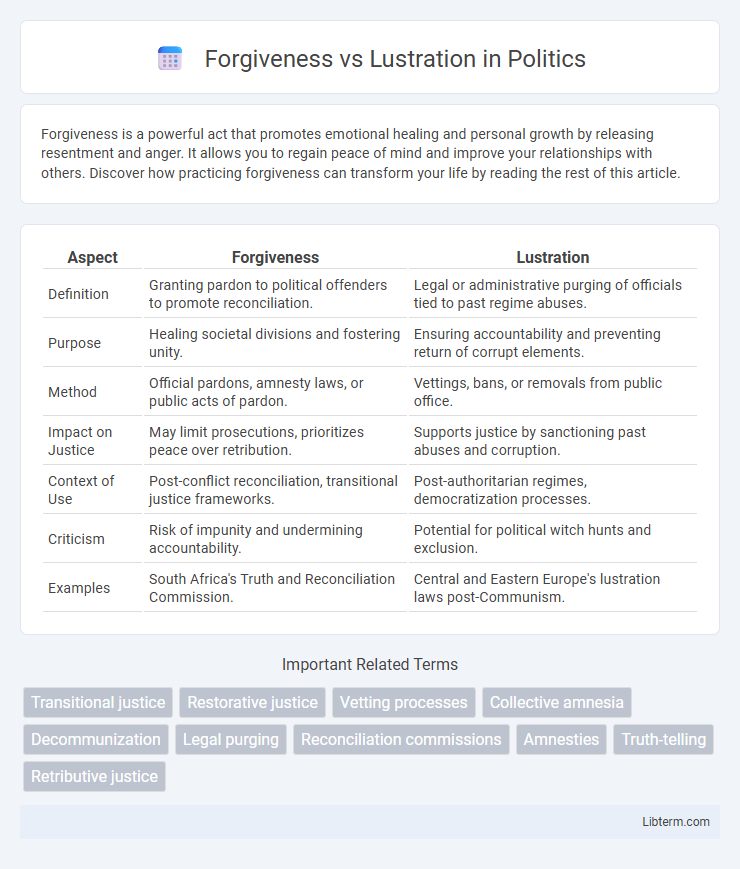Forgiveness is a powerful act that promotes emotional healing and personal growth by releasing resentment and anger. It allows you to regain peace of mind and improve your relationships with others. Discover how practicing forgiveness can transform your life by reading the rest of this article.
Table of Comparison
| Aspect | Forgiveness | Lustration |
|---|---|---|
| Definition | Granting pardon to political offenders to promote reconciliation. | Legal or administrative purging of officials tied to past regime abuses. |
| Purpose | Healing societal divisions and fostering unity. | Ensuring accountability and preventing return of corrupt elements. |
| Method | Official pardons, amnesty laws, or public acts of pardon. | Vettings, bans, or removals from public office. |
| Impact on Justice | May limit prosecutions, prioritizes peace over retribution. | Supports justice by sanctioning past abuses and corruption. |
| Context of Use | Post-conflict reconciliation, transitional justice frameworks. | Post-authoritarian regimes, democratization processes. |
| Criticism | Risk of impunity and undermining accountability. | Potential for political witch hunts and exclusion. |
| Examples | South Africa's Truth and Reconciliation Commission. | Central and Eastern Europe's lustration laws post-Communism. |
Understanding Forgiveness and Lustration
Forgiveness involves the personal and emotional process of letting go of resentment towards wrongdoers, fostering reconciliation and healing. Lustration refers to the official political or legal purging of individuals associated with past abuses, aiming to restore public trust and prevent impunity. Understanding forgiveness emphasizes individual healing, while lustration prioritizes systemic accountability and societal reform.
Historical Context of Transitional Justice
Forgiveness in transitional justice emphasizes reconciliation and social healing by allowing societies to move forward without prolonged retribution, often essential in post-conflict or authoritarian regimes. Lustration involves the systematic removal of individuals associated with past abuses from public office, serving as a mechanism to restore trust in institutions and prevent recurrence of injustice. Both approaches reflect differing strategies to address legacies of political violence and human rights violations, shaped by the specific historical and cultural contexts of countries undergoing democratization.
Key Principles of Forgiveness
Forgiveness centers on compassion, acknowledging wrongdoing while releasing resentment and fostering emotional healing. Key principles include empathy toward the offender, acceptance of past harm without seeking retribution, and commitment to moving forward constructively. Unlike lustration, which involves institutional purification and legal accountability, forgiveness focuses on personal reconciliation and restoration of relationships.
Lustration: Definition and Objectives
Lustration refers to the official process of screening and removing individuals associated with past authoritarian regimes from positions of power, typically within government or public institutions. Its primary objective is to prevent the recurrence of abuses and ensure political and social accountability by barring former regime collaborators from influential roles. This legal mechanism aims to promote transparency, restore public trust, and facilitate a democratic transition by addressing historical injustices.
Moral and Ethical Considerations
Forgiveness entails a moral commitment to healing and reconciliation by acknowledging past wrongs and offering grace, which promotes social cohesion and personal transformation. Lustration involves ethical accountability through formal investigations and sanctions aimed at preventing future abuses and ensuring justice within transitional societies. Balancing forgiveness and lustration requires weighing the values of mercy against the imperatives of justice to achieve societal stability and moral repair.
Societal Impacts of Forgiveness
Forgiveness fosters societal healing by promoting reconciliation and reducing cycles of resentment and violence in post-conflict communities. It enables inclusive dialogue, helps rebuild trust among divided groups, and supports the restoration of social cohesion. By emphasizing empathy and moral rehabilitation, forgiveness contributes to long-term stability and collective well-being.
Political Consequences of Lustration
Lustration policies systematically exclude former regime collaborators from public office, fostering transitional justice but often polarizing societies and entrenching political divisions. These measures can enhance accountability and restore public trust in governance by removing compromised officials, yet they may provoke backlash from affected groups and hinder political reconciliation. The political consequences of lustration include destabilized party systems and difficulties in building inclusive democratic institutions in post-authoritarian contexts.
Case Studies: Global Examples
Case studies of forgiveness versus lustration reveal diverse approaches to transitional justice worldwide, such as South Africa's Truth and Reconciliation Commission prioritizing forgiveness and restorative justice to heal apartheid-era wounds. In contrast, post-communist Eastern European countries like Poland implemented lustration policies to purge former regime collaborators from positions of power, aiming to ensure political transparency and public trust. These global examples demonstrate how forgiveness fosters societal healing while lustration enforces accountability, reflecting different cultural and political contexts in addressing past injustices.
Balancing Justice and Reconciliation
Balancing justice and reconciliation requires understanding the distinct roles of forgiveness and lustration in post-conflict societies. Forgiveness promotes social healing by allowing victims to release resentment, fostering communal harmony, while lustration serves as a legal and political tool to hold perpetrators accountable and prevent future abuses. Effective transitional justice combines both approaches to ensure accountability without sacrificing the possibility of societal restoration.
Future Prospects for Conflict Resolution
Forgiveness promotes reconciliation by fostering personal healing and social cohesion, creating a foundation for long-term peacebuilding in post-conflict societies. Lustration, through institutional accountability and removing compromised officials, aims to prevent the recurrence of abuses and restore public trust in governance structures. Combining both approaches can enhance sustainable conflict resolution by addressing individual grievances alongside systemic reforms, thereby supporting democratic transitions and stability.
Forgiveness Infographic

 libterm.com
libterm.com